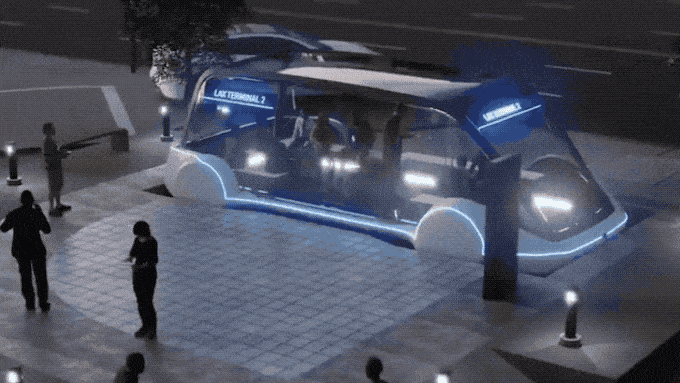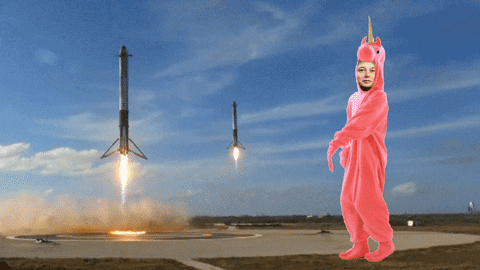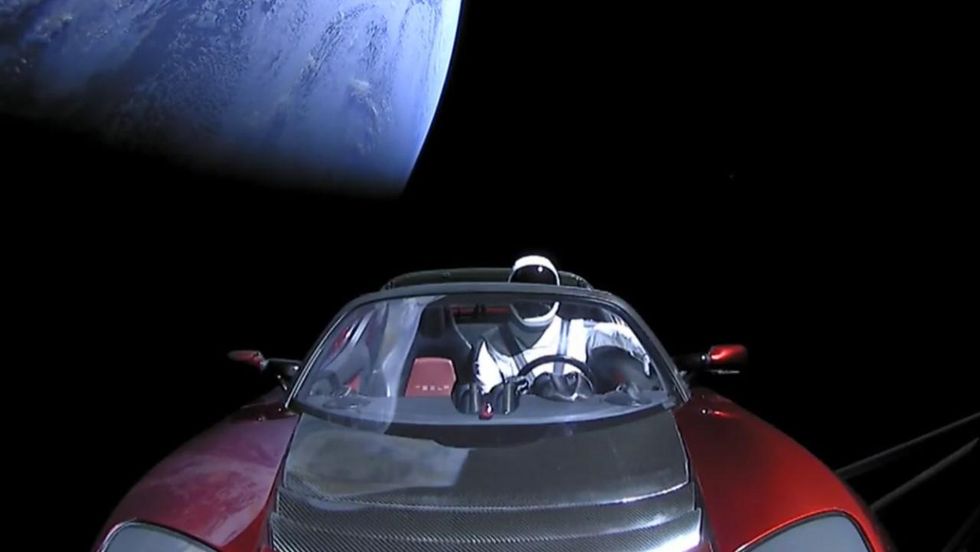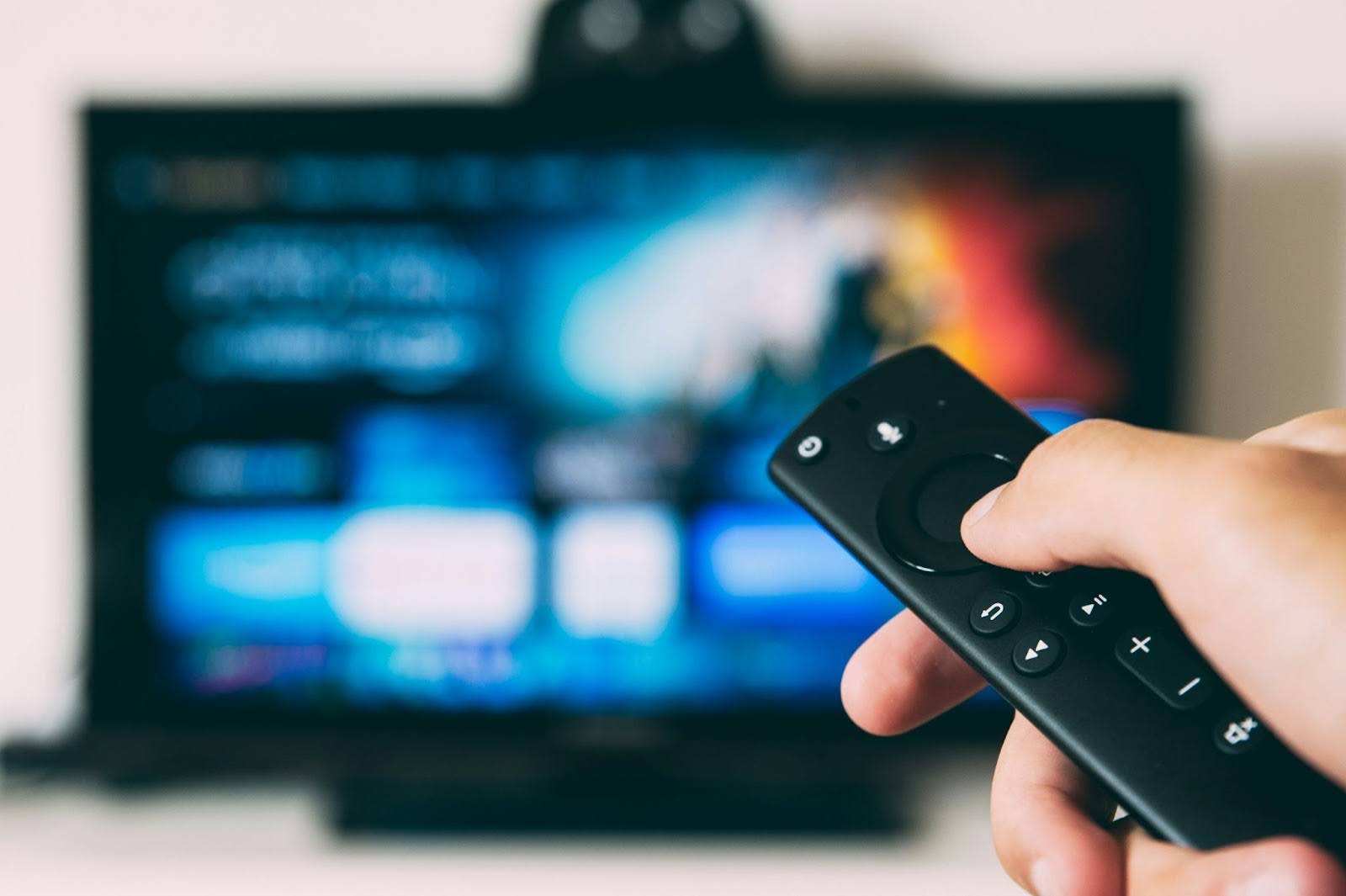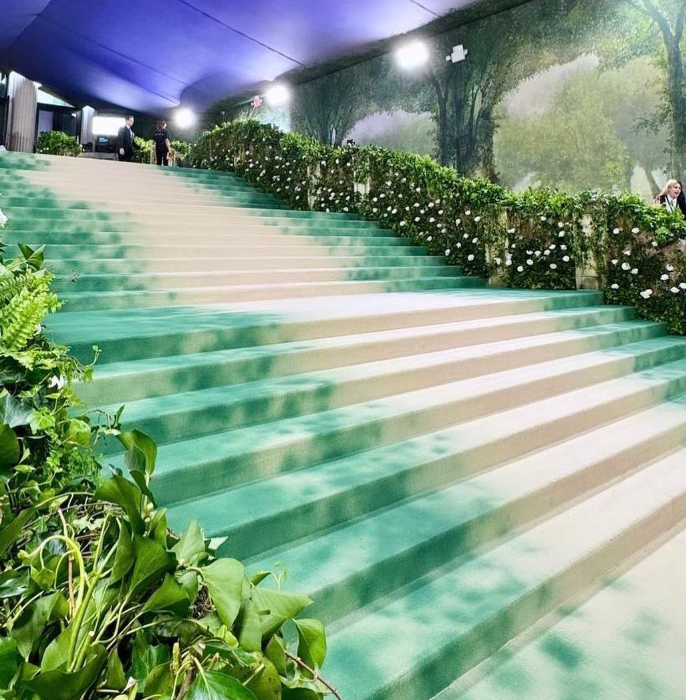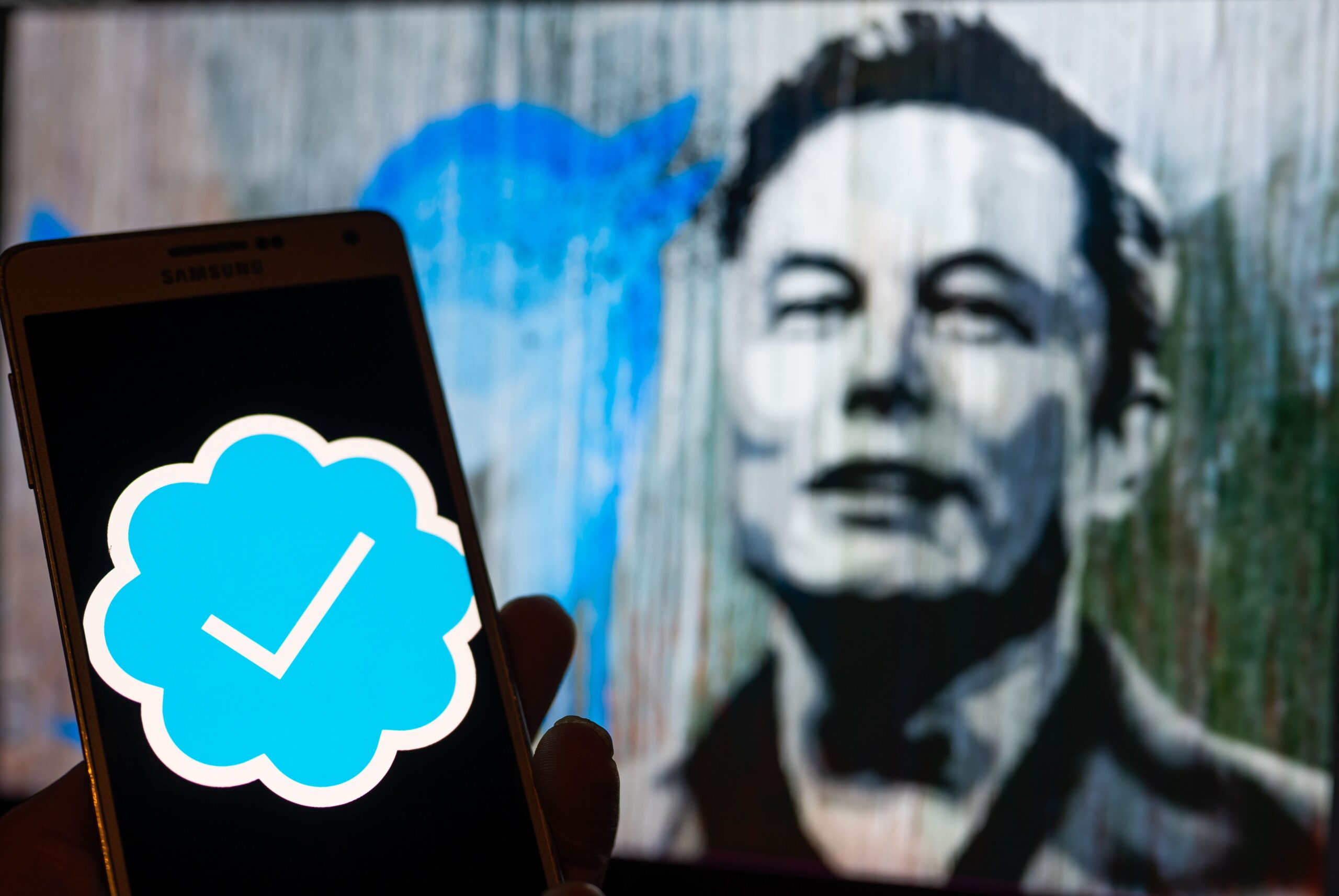
Elon Musk Photo illustration
by Jonathan Raa_NurPhoto (Shutterstock)
Elon Musk gets a lot of credit for his contributions to technology.
It’s on the basis of his supposed genius as a tech-mogul/inventor that people take him seriously when he talks about wild ideas like a Neuralink chip that “could solve paralysis, blindness, hearing,” or the so-called Hyperloop, supersonic train system.
For those unfamiliar, the Hyperloop is a proposed underground vacuum-tube system that would theoretically shuttle passengers at supersonic speeds, connecting distant cities in mere minutes. If that sounds a little too good to be true, well…there are still some details to be worked out. Like, decades of details.
But the important thing is that Elon Musk is taking steps in that futuristic direction. Or at least, that’s how he makes it seem.
Loops in Theory
Specifically, for a smaller-scale, intraurban transit Loop Musk has proposed ditching the vacuum tube, the supersonic speeds, and — most importantly — the train. Rather, these systems would use massive elevators to move vehicles underground, into narrow, single-lane tunnels where they could be moved along at high speeds, either by boarding electric “sleds” or through the use of self-driving software.
While there could still be “pods” to ferry larger groups of people, Musk’s focus has been largely on solutions for existing private vehicles. And particularly for vehicles manufactured by Tesla.
He has frequently talked about how he intends to “solve traffic” by moving it underground, with dedicated lanes that — according to Musk — could be added to in layers of tunnels, expanding downward to meet demand. Needless to say, this model presents its own engineering, let alone urban planning challenges.
Among these challenges is the well-documented phenomenon of induced demand, which occurs when a heavily-trafficked area adds or expands roads to decrease congestion. When this effort is successful, it makes driving — as opposed to mass transit — a more appealing option for getting around.
This leads to more cars on the road, which leads to more congestion, which leads to more expansion, until entire sections of city are converted into hellscapes of clogged, criss-crossing, eight-lane overpasses that spew pollutants or — when clogged with electric cars — use up energy generated at power plants that spew pollutants.
At first blush, it doesn’t seem like just moving this process underground does much to alleviate the problem. But don’t worry, Elon Musk’s brilliant solution to induced demand is…just to deny that it’s a thing.
Still, municipal governments seem to be all too willing to take that bait and meet Elon halfway…or maybe three quarters of the way… Okay, he’s doing at least 10% of what he promised.
Loops in Practice
At least two cities are now entrusting his Boring Company with providing a version of that incredible transit technology — with likely a number of other secret deals in the works. But in the only instance where something has been built, it’s a Loop minus everything that makes it cool or useful.
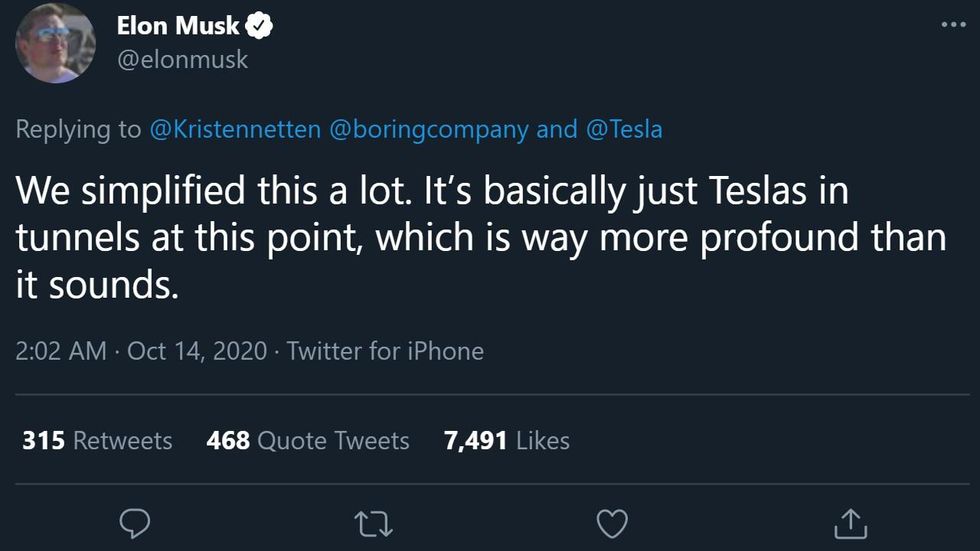
The Las Vegas Convention and Visitors Authority paid Elon Musk millions of dollars for a futuristic, high-speed, high-occupancy autonomous shuttle system that was supposed to transport 4400 passengers per hour. But when the system debuted in May, what they got instead was…basically none of that.
The Las Vegas Convention Center (LVCC) Loop involves a fleet of underground Tesla cabs that need drivers, and max out at 35 miles per hour. Those Teslas move through claustrophobic tunnels around a 1.7 mile loop, with three stops serving different sections of the convention center.
On top of that, while tests have supposedly confirmed that the system can handle its required 4400 passenger-per-hour capacity, some basic arithmetic seems to indicate that it will struggle to transport even half that many. If that’s true, the system would leave most convention-goers to either wait in long lines for a ride, or make the trek on foot just as they did in the distant, benighted past of 2019.
The tunnels also feature no apparent ventilation or drainage, no route for pedestrians to safely exit in the event of a breakdown — assuming the doors can even open wide enough for them to climb out — and no fire suppression system. Thankfully, Tesla cars aren’t known for catching on fire. Oh, wait…
Elon Musk’s Las Vegas Loop could have been greatwww.youtube.com
And still, this stripped-down loop was delivered four months late, at about $8 million over the original budget. But hey, the tunnels have cool color-changing LEDs, so…that’s something. Elon must have really broken the bank on those.
Fool Us Once…
Part of the promise of the Boring company is that it’s supposed to make tunnel construction so cheap that the money for this kind of project can be shifted to its other components. But that doesn’t seem to have happened in the case of the LVCC Loop.
Instead of 150-mph autonomous shuttles, moving 12 passengers at a time, a fleet of existing Tesla vehicles are being used at low speeds and carrying a maximum of four passengers each.
The Convention Center could have used the same tunnels to move a lot more people with a conventional tram system, or a smaller fleet of electric vans, or some moving walkways, or…about a dozen other options.
Hell, even golf carts would be a better option, since you could buy twice as many for half the cost with less waste. But perhaps none of these alternatives would have been quite as much of a balm to Elon’s ego.
The City of Golf Cartswww.youtube.com
Is it too harsh to suggest that he could actually be that fragile and full of himself? Well, considering his ex-wife’s claim that, at their wedding reception, he told her “I am the alpha in this relationship,” maybe not.
And for all the fanfare surrounding the LVCC Loop, the self-serving decision to use Teslas could end up costing Musk and The Boring Company millions in fines for falling short of expected passenger capacity.
So, given the massive failure to deliver what was promised, why are there plans to expand this system, with additional stops serving the Las Vegas strip? And why has the city of Fort Lauderdale, Florida just announced plans to accept The Boring Company’s proposal for a transit system connecting their downtown to Las Olas Beach?
Is Fort Lauderdale just banking on the buzz and fawning press attention we saw in Las Vegas? Will more of the Kardashian-Jenner clan be summoned for over-enthusiastic test drives of the Las Olas loop?
Presumably there is a limit on how much tourism can be drawn in by the prospect of a low-speed ride in a slightly-less-creepy version of the Willy Wonka tunnel. Is that really enough to warrant these projects, or are these municipal governments just dumb enough to keep buying into the hype?
Kylie Jenner showing off The Boring Company tunnel in Las Vegas nn @elonmuskpic.twitter.com/wwN0yc9zIx— SAINT (@SAINT) 1618370965
The proposed Loop would ferry passengers to and from the Las Olas Beach, around 3 miles away from Fort Lauderdale’s downtown, with yet another fleet of Tesla taxis. It’s a substantially larger project than the LVCC Loop — which took around three years to complete — yet Musk is promising to have it done in six months, for about half the cost of Las Vegas system. How?
Part of the answer is likely the development of the Prufrock, The Boring Company’s new, faster boring machine, which genuinely seems like some impressive tech, and is reportedly able to dig around a mile of tunnel in just one week. Add that to the fact that the company has completed one Loop project already, and it may seem like smooth sailing ahead.
But does this optimistic assessment take into account the limestone under Fort Lauderdale — which poses different challenges than the sandstone under Vegas? Does it include considerations for the vital protection of southern Florida’s shallow and vulnerable aquifer?
A Better Option
While official approval for the project is pending, with an option for competing proposals from other companies, the city only allowed 45 days for proposals to be submitted. It’s a timeline that makes it unlikely any serious contenders will have a chance to make a bid.
Which is really unfortunate, because just about any company could theoretically swoop in and offer the same exact problematic tunnels, but with a small train/tram system in place of taxis. That simple modification would blow Musk out of the water in terms of passenger miles, energy efficiency, and operational costs.
After all, putting trains in underground tunnels has been standard practice for well over a century, and it works pretty beautifully. Considering the fact that more than 200 people can be transported in a single New York City subway car, wouldn’t some variation on that be the obvious solution?
While The Boring Company’s 12-foot tunnels can’t quite accommodate traditional subway trains — which generally require around 17 feet or more — they could still allow for vehicles that can carry far more passengers, far more efficiently than a bunch of Teslas ever could. So why don’t Elon Musk and the Boring company just do that?
With a little of Tesla’s engineering talent, and a fraction of their tens-of-billions in liquid capital, it seems like adding a simple, high-capacity chassis and interior on top of existing Tesla hardware would be an easy option. Particularly if that vehicle only needs to operate at low speeds, in a controlled tunnel environment.
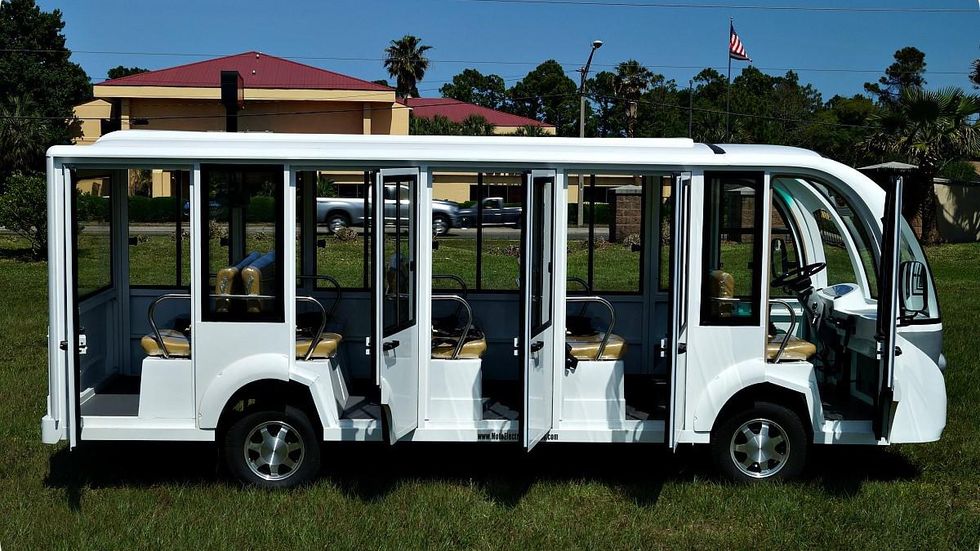
The challenges involved with transporting 8 or 10 or 12+ passengers instead of 4 would be pretty negligible. And could save everyone some money — passengers are currently expected to pay between $5-$7 for a short, private ride. So what’s stopping them?
Is it because this simple, practical solution isn’t “cool” enough for Musk’s crypto-bro, Rick and Morty, Cybertruck persona? Is this a 21st century remake of General Motors’ conspiracy to accelerate the decline of America’s streetcars? Or does Elon Musk just hate public transit?
Taking the Public out of Transit
While it’s worth keeping in mind that the CEO of the world’s most valuable car company has a lot to gain from keeping cars at the center of American life, it also seems to be true that he just really dislikes public transit — in particular the part about being around other people.
This isn’t just idle speculation. Musk shared his thoughts on the issue in 2017 at a Tesla event for the Neural Information Processing Conference, and his distaste was clear:
“I think public transport is painful. It sucks. Why do you want to get on something with a lot of other people, that doesn’t leave where you want it to leave, doesn’t start where you want it to start, doesn’t end where you want it to end … there’s like a bunch of random strangers, one of who might be a serial killer, OK, great. And so that’s why people like individualized transport.”
It’s a great argument for cars, as long as you don’t consider literally any other factor. Because of course most people would choose privacy and comfort over cramped shared conditions, all things being equal, but all things are not equal.
In particular environmental harm, operational costs, capacity limits, and the price per ride are distinctly different for individualized transport vs. mass transit. It’s the difference between normal shipping and overnight shipping — and there’s a reason we don’t overnight everything that needs to be shipped.
Musk might as well say, “People like hot tubs. That’s why we’re building a public transit system around a fleet of hot tub limos.”
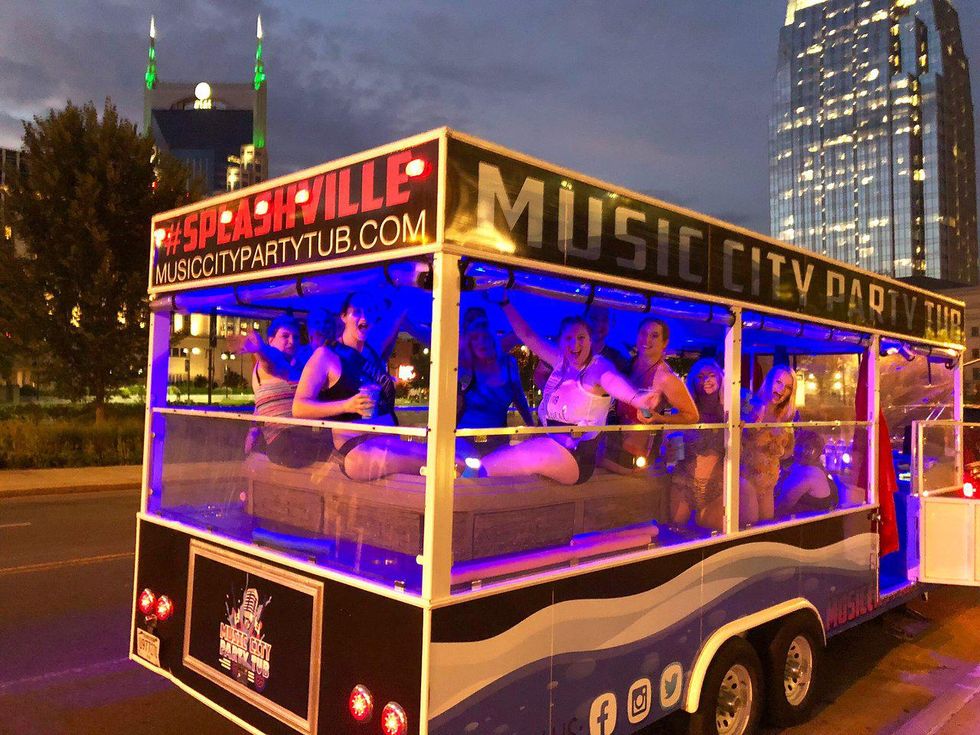
Obviously that’s absurd. But the reasons it doesn’t make sense to heat and haul around 1500 pounds of hot water apply just as well to the prospect of a fleet of 62 cars that could be replaced with 10 trams/mini-buses. The waste involved simply in moving that many thousands of pounds of metal around a loop all day — not to mention the required mining and manufacturing process — is staggering.
And it would be laughable to suggest that a man who’s made much of his unconscionably large fortune selling “green tech” doesn’t understand the irreducible environmental cost of choosing individual vehicles over shared transport.
But since Elon has this personal vendetta against public transit — and is banking his wealth on a future in which everyone has an electric car — he may simply prefer to ignore it.
But…He’s a Genius
Then again, this analysis must be missing something. Elon Musk wouldn’t be spending so much time on these projects if they were stupid. He’s a genius, right?
He’s the inventor who made all-electric cars really work, broke crash-safety records, and figured out how to make giant rockets do that kickass vertical landing. Right?
There’s no way he’s just a weird dude whose uncomfortable around people, and assumes everyone is like him. There’s no way The Boring Company started as a childish daydream about a private tunnel to take Musk directly from his home to his work. Right?!
Sorry to disappoint you, but no. Elon Musk is not the master-of-all-trades, real-life Tony Stark genius we’ve been led to believe he is.
He is, admittedly, very smart in some way. By all accounts he showed talent as a programmer from a young age. He’s undeniably a canny investor and businessman, and he has a certain flawed brilliance when it comes to marketing himself and his companies — 420 jokes aside.
But none of that makes him a genius. No one who — in mid-March of 2020 — said that Covid in the US was weeks away from being “close to zero new cases” could possibly be a genius.
Even without every other dumb thing Elon Musk has said and done, that tweet alone handily disproves the case for true general intelligence. There is no genius that applies across disciplines — no smart person whose opinions should be taken seriously across the board.
So why can elon Musk open his mouth on literally any topic and have fanboys, investors, and local governments falling over each other to give him their money? Because our culture has a sick, vestigial tendency to confuse wealth for merit, and Elon Musk’s niche of intelligence has been well suited to make him incomprehensibly wealthy — he could buy literally every home in Wyoming, Vermont, and Alaska at market value.
He’s so inconceivably rich, in fact, that a $900 million venture digging tunnels to put his cars in — he already put one in space, so he’s clearly running out of places to stick them — is the equivalent of an average American spending $600 on their hobby…
A Petty, Vindictive Nerd
Not a genius. Not a savior. A billionaire nerd (which is only marginally better than a regular billionaire) who doesn’t deserve even a fraction of the credit he’s given as an “inventor.”
He didn’t “invent” any of the cars at Tesla, and only became a “co-founder” of the company on paper after investing $6.5 million in the previously Incorporated Tesla Inc., which actual founders Martin Eberhard and Marc Tarpenning had already conceived of as “a car manufacturer that is also a technology company.”
Elon Musk invested in a promising company in an emerging industry. He promoted the hell out of it (while also heavily promoting himself), took advantage of every government subsidy and tax credit he possibly could, and was able to hire some of the best engineering talent in the world for relatively cheap — because a lot of people want to work on the future of green technology. All this while endangering manufacturing workers and extorting local governments to save a buck.
Tesla CEO Elon Musk Tried to Destroy a Whistleblowerwww.youtube.com
Likewise with SpaceX, while he did at least found the company — and had an innovative approach to cutting costs — he owes much of his success there to the simple fact that a lot of smart, talented people were interested in space travel. He did not design those (admittedly awesome, if a bit explodey) rockets.
None of his success is evidence that he is some sort of next-level genius who is seeing the matrix and building the future. He is ultimately a petty, stubborn, self-aggrandizing man who hoards wealth, avoids taxes, viciously attacks his critics, (allegedly) swats employees, and dismisses reality when it isn’t to his liking.
Those traits have occasionally served him well in achieving goals that others would find too daunting. Would he have been able to turn a tiny electric car company into a major global brand if he had listened to the naysayers? Would he be able to attract so much engineering talent to so many cutting-edge projects if he didn’t zealously promote — and occasionally exaggerate — his vision for each technology?
But when we’re talking about a man who manufactures cars and hates public transit, now being entrusted to develop a system for moving lots of people as efficiently as possible…maybe that petty, stubborn resistance to reality is not the best attribute.
It seems to have him pettily fixated entirely on what he wants to change about his own congested, “soul-destroying” commute — at the expense of the masses of non-billionaire people who also exist. And it seems increasingly likely that, as a result, multiple cities will be left with legacies of expensive, limited-use infrastructure that only looks futuristic for a few years, and only serves a fraction of the people it should — before being abandoned.
For a preview of what that looks like, just look at all the abandoned monorail projects around the world — and in Vegas itself. Once upon a time they seemed like a great, futuristic option — much more exciting than traditional trains, streetcars, or buses. Now they’re expensive scrap taking up space in places where space is already at a premium.
A Missed Opportunity
After World War II, while European nations developed their train systems, the United States invested in a hyper-individualist vision of the future dreamed up by car companies: every worker and every family in their own motorized privacy bubble on four wheels.
How The Auto Industry Carjacked The American Dream | Climate Townwww.youtube.com
Every city built around those moving private spaces, and any point on the map connected to every other via an incredible network of interstate highways that required orders of magnitude more space and material than equivalent railroads, and massively disrupted natural habitats and migration patterns for hundreds of vital species.
Still, the fact that such an ambitious dream was made a reality is nothing short of miraculous. The planning, engineering, and construction of such an immense system of roads was an almost unfathomable undertaking, and has been referred to as “the greatest public works project in American history.”
In the aftermath, the rate of vehicle ownership shot up, and sprawling suburbs full of white people sprouted like weeds around every American city. The nation had been remade in the car’s image.
But if we had known then what we know now about the threat of fossil fuels and runaway climate change, would we still have done it? Might we have reconsidered the value of the boring, familiar, yet-to-be-bested train?
In retrospect it’s obvious that we missed an opportunity to connect the nation with a system of high-speed railways. An oversight we’ve spent recent years struggling to correct — without much progress.
And, in retrospect, cities built around foot traffic and public transit are much cleaner and more pleasant than cities built for cars. Which is why so many local governments have started taking steps to limit or cut off vehicle access to city centers.
While we still have a long way to go to correct our errors in these cases, we must know better by now… Right?
Sadly, as G.I. Joe taught us, knowing is only half the battle. And the other half — the half that involves changing our destructive, short-sighted habits — is a great deal harder. For some of us anyway…
Los Angeles nixed Musks “Dugout Loop” to Dodgers stadium for reasons that should be obvious. And officials from Virginia, who were given a tour of one of The Boring Company’s tunnels back in 2019, were likewise left appropriately underwhelmed.
Elon Musk’s Dugout Loop – The DISASTER That Almost Happenedwww.youtube.com
But not everywhere is so lucky. It seems that all it took to make Vegas and Fort Lauderdale’s representatives fall back in love with the car-centric model was to make the cars marginally better for the environment, and throw them into a light-up tunnel.
And now those cities seem poised to repeat the same mistakes — to once again allow a car manufacturer to shape and sabotage public transit for his own ends.
The Silver Lining
For everything that’s bad, depressing, and foreboding about the construction of The Boring Company’s Loops, there is a faint shimmering cause for hope: There’s nothing about them that requires the use of Teslas. They’re just tunnels.
Their simplicity exposes the flimsy fantasy of Musk’s hyper-futuristic transit vision— no sleds, no elevators, no air-tight seal to allow for near-vacuum. It’s another fiction like the miniature child-rescuing submarine, Starlink’s “cheap” “high-speed” Internet, Tesla’s “true” autopilot, Boring’s affordable housing bricks, or SpaceX’s heavily asterisked timeline for Mars — Elon Musk always over-promises and always under-delivers.
But in this case the simplicity may actually be their best feature. Assuming the tunnels don’t succumb to some glaring structural flaw that Elon Musk cajoled his engineers into overlooking — which may be too optimistic, as the ride already looks a bit bumpy — Las Vegas and Fort Lauderdale could walk away from Musk with some cheapish tunnels (and possibly some gently used Teslas for resale).
Then just replace the cars with trams or carts or moving walkways, or any of the other, more efficient options mentioned above, and voila! A functional transit system.
While purpose-built public transit infrastructure would obviously be better, at least the tunnels wouldn’t go to waste. They could even be mixed-use tunnels, with normal people hopping on cheaper trams while wealthy sociophobes like Musk opt for rides in private vehicles.
This mix was previously proposed by Musk, but he seems to be in denial of the fact that his Loops become obscene and incoherent without it. And so, the current LVCC Loop and proposed Las Olas Loop have abandoned that sensible solution in favor of overpriced, dedicated taxi lanes with long wait times. Cool…
The Upshot
In a year when the only news story more frequent than the billionaire vanity-project space race — Richard Branson last week, Jeff Bezos this — is the occurrence of terrifying, “once in a century” extreme weather, what are we meant to take away from this? What lesson is there in the fact that a vital shift toward public transit is allowed to be so badly mismanaged by a man who is more interested in sending a car to space than he is in actually being the green icon he pretends to be?
Is there anything we can learn here — beyond the obvious fact that our culture is terminally diseased, and needs to be massively reformed and restructured to avert the actual climate apocalypse? Yes.
While it remains to be seen whether the planned expansion in Las Vegas and the Las Olas Loop in Fort Lauderdale will become realities — or if city officials will come to their senses and stop indulging Elon’s weird car-tunnel hobby — we can still walk away with these important insights.
- Smart in a few ways can still be incredibly dumb in many others.
- If something sounds too good to be true it probably is.
- Never let a weird train-hating billionaire design your city’s mass transit.
